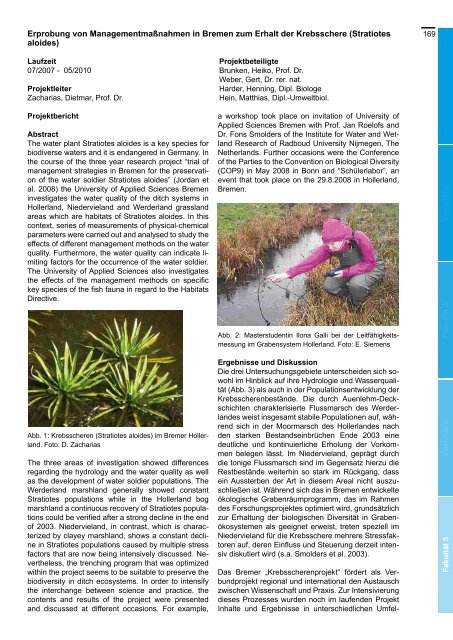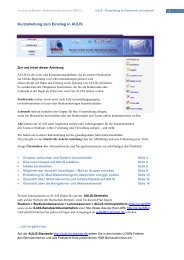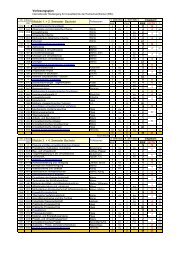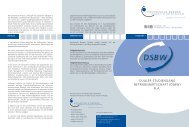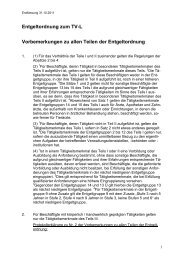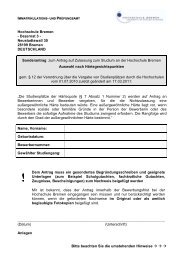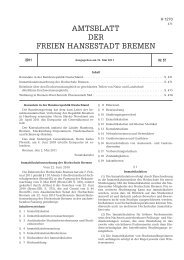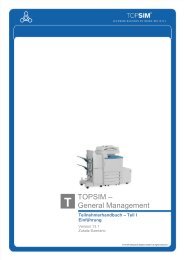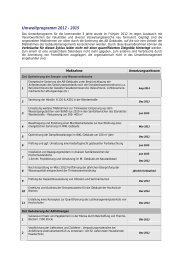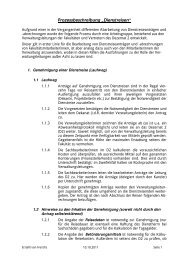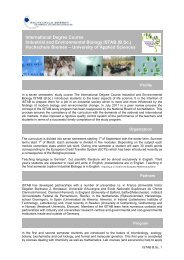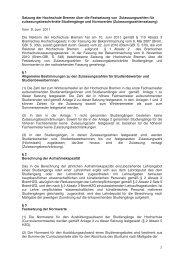Forschungsbericht 2010 - 2011 - Hochschule Bremen
Forschungsbericht 2010 - 2011 - Hochschule Bremen
Forschungsbericht 2010 - 2011 - Hochschule Bremen
Sie wollen auch ein ePaper? Erhöhen Sie die Reichweite Ihrer Titel.
YUMPU macht aus Druck-PDFs automatisch weboptimierte ePaper, die Google liebt.
Erprobung von Managementmaßnahmen in <strong>Bremen</strong> zum Erhalt der Krebsschere (Stratiotes<br />
aloides)<br />
Laufzeit Projektbeteiligte<br />
07/2007 - 05/<strong>2010</strong> Brunken, Heiko, Prof. Dr.<br />
Weber, Gert, Dr. rer. nat.<br />
Projektleiter Harder, Henning, Dipl. Biologe<br />
Zacharias, Dietmar, Prof. Dr. Hein, Matthias, Dipl.-Umweltbiol.<br />
Projektbericht<br />
Abstract<br />
The water plant Stratiotes aloides is a key species for<br />
biodiverse waters and it is endangered in Germany. In<br />
the course of the three year research project “trial of<br />
management strategies in <strong>Bremen</strong> for the preservation<br />
of the water soldier Stratiotes aloides” (Jordan et<br />
al. 2008) the University of Applied Sciences <strong>Bremen</strong><br />
investigates the water quality of the ditch systems in<br />
Hollerland, Niedervieland and Werderland grassland<br />
areas which are habitats of Stratiotes aloides. In this<br />
context, series of measurements of physical-chemical<br />
parameters were carried out and analysed to study the<br />
effects of different management methods on the water<br />
quality. Furthermore, the water quality can indicate limiting<br />
factors for the occurrence of the water soldier.<br />
The University of Applied Sciences also investigates<br />
the effects of the management methods on specific<br />
key species of the fish fauna in regard to the Habitats<br />
Directive.<br />
Abb. 1: Krebsscheren (Stratiotes aloides) im Bremer Hollerland.<br />
Foto: D. Zacharias<br />
The three areas of investigation showed differences<br />
regarding the hydrology and the water quality as well<br />
as the development of water soldier populations. The<br />
Werderland marshland generally showed constant<br />
Stratiotes populations while in the Hollerland bog<br />
marshland a continuous recovery of Stratiotes populations<br />
could be verified after a strong decline in the end<br />
of 2003. Niedervieland, in contrast, which is characterized<br />
by clayey marshland, shows a constant decline<br />
in Stratiotes populations caused by multiple stress<br />
factors that are now being intensively discussed. Nevertheless,<br />
the trenching program that was optimized<br />
within the project seems to be suitable to preserve the<br />
biodiversity in ditch ecosystems. In order to intensify<br />
the interchange between science and practice, the<br />
contents and results of the project were presented<br />
and discussed at different occasions. For example,<br />
a workshop took place on invitation of University of<br />
Applied Sciences <strong>Bremen</strong> with Prof. Jan Roelofs and<br />
Dr. Fons Smolders of the Institute for Water and Wetland<br />
Research of Radboud University Nijmegen, The<br />
Netherlands. Further occasions were the Conference<br />
of the Parties to the Convention on Biological Diversity<br />
(COP9) in May 2008 in Bonn and “Schülerlabor”, an<br />
event that took place on the 29.8.2008 in Hollerland,<br />
<strong>Bremen</strong>.<br />
Abb. 2: Masterstudentin Ilona Galli bei der Leitfähigkeitsmessung<br />
im Grabensystem Hollerland. Foto: E. Siemens<br />
Ergebnisse und Diskussion<br />
Die drei Untersuchungsgebiete unterscheiden sich sowohl<br />
im Hinblick auf ihre Hydrologie und Wasserqualität<br />
(Abb. 3) als auch in der Populationsentwicklung der<br />
Krebsscherenbestände. Die durch Auenlehm-Deckschichten<br />
charakterisierte Flussmarsch des Werderlandes<br />
weist insgesamt stabile Populationen auf, während<br />
sich in der Moormarsch des Hollerlandes nach<br />
den starken Bestandseinbrüchen Ende 2003 eine<br />
deutliche und kontinuierliche Erholung der Vorkommen<br />
belegen lässt. Im Niedervieland, geprägt durch<br />
die tonige Flussmarsch sind im Gegensatz hierzu die<br />
Restbestände weiterhin so stark im Rückgang, dass<br />
ein Aussterben der Art in diesem Areal nicht auszuschließen<br />
ist. Während sich das in <strong>Bremen</strong> entwickelte<br />
ökologische Grabenräumprogramm, das im Rahmen<br />
des Forschungsprojektes optimiert wird, grundsätzlich<br />
zur Erhaltung der biologischen Diversität in Grabenökosystemen<br />
als geeignet erweist, treten speziell im<br />
Niedervieland für die Krebsschere mehrere Stressfaktoren<br />
auf, deren Einfluss und Steuerung derzeit intensiv<br />
diskutiert wird (s.a. Smolders et al. 2003).<br />
Das Bremer „Krebsscherenprojekt“ fördert als Verbundprojekt<br />
regional und international den Austausch<br />
zwischen Wissenschaft und Praxis. Zur Intensivierung<br />
dieses Prozesses wurden noch im laufenden Projekt<br />
Inhalte und Ergebnisse in unterschiedlichen Umfel-<br />
169<br />
Fakultät 1<br />
Fakultät 2<br />
Fakultät 3<br />
Fakultät 4<br />
Fakultät 5


